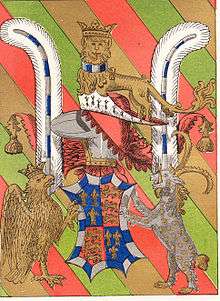Achievement (heraldry)
An achievement, armorial achievement or heraldic achievement (historical: hatchment) in heraldry is a full display or depiction of all the heraldic components to which the bearer of a coat of arms is entitled.[2] An achievement comprises not only the arms themselves displayed on the Escutcheon, the central element, but also the following elements surrounding it:
- Crest placed atop a:
- Torse (or Cap of Maintenance as a special honour)
- Mantling
- Helm of appropriate variety; if holder of higher rank than a baronet, issuing from a:
- Coronet or Crown (not used by baronets), of appropriate variety.
- Supporters (if the bearer is entitled to them, generally in modern usage not baronets), which may stand on a Compartment)
- Motto, if possessed
- Order, if possessed
- Badge, if possessed
| Part of a series on |
| Heraldic achievement |
|---|
| External devices in addition to the central coat of arms |
|
|

Coat of arms
Sometimes the term "coat of arms" is used to refer to the full achievement, but this usage is wrong in the strict sense of heraldic terminology, as a coat of arms refers to a garment with the escutcheon or armorial achievement embroidered on it.[3][4]
Hatchment

The ancient term used in place of "achievement" was "hatchment", being a corruption (through such historic forms as atcheament, achement, hathement, etc.) of the French achèvement,[5] from the verb achever, a contraction of à chef venir ("to come to a head"), ultimately from Latin ad caput venire, "to come to a head",[6] thus to reach a conclusion, accomplish, achieve. The word "hatchment" in its historical usage is thus identical in meaning and origin to the English heraldic term "achievement". However, in recent years the word "hatchment" has come to be used almost exclusively to denote "funerary hatchment", whilst "achievement" is now used in place of "hatchment" in a non-funereal context. An example of the historic use of "hatchment" in a non-funerary context to denote what is now termed "achievement" is in the statute of the Order of the Garter laid down by King Henry VIII (1509–1547) concerning the regulation of Garter stall plates:[7]
It is agreed that every knyght within the yere of his stallation shall cause to be made a scauchon of his armes and hachementis in a plate of metall suche as shall please him and that it shall be surely sett upon the back of his stall.
References
- Planche, J.R., Pursuivant of Arms, 1851, p. xx
- Boutell, Charles & Charles Fox-Davies, Arthur (1914), The handbook to English heraldry, Reeves & Turner, p. 100,
Achievement, or Achievement of Arms. Any complete composition of Arms.
- A.G. Puttock, A Dictionary of Heraldry and Related Subjects, Exeter 1985. Blaketon Hall. ISBN 0907854931. p. 40
- Stephen Friar (ed.), A New Dictionary of Heraldry, London 1987. Alphabooks/A&C Black. ISBN 0906670446. p. 96.
- Collins Dictionary of the English Language, London, 1986
- Larousse Dictionnaire de la Langue Francaise, Paris, 1979: "lat. pop. capum, class. caput
- Round, J. Horace, Family Origins and Other Studies, Page, William, (ed.), London, 1930, pp. 174–89, The Garter Plates and Peerage Styles, p. 174
External links
- "What is an Achievement?". An Tir College of Heralds. Archived from the original on 20 April 2011. Retrieved 16 May 2011.
An 'achievement' is a full formal display of a coat of arms.
| Wikimedia Commons has media related to Armorial achievements. |